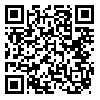Sat, Apr 27, 2024
Volume 32, Issue 2 (3-2022)
JHNM 2022, 32(2): 89-97 |
Back to browse issues page
Download citation:
BibTeX | RIS | EndNote | Medlars | ProCite | Reference Manager | RefWorks
Send citation to:



BibTeX | RIS | EndNote | Medlars | ProCite | Reference Manager | RefWorks
Send citation to:
Ghaffari Sardasht F, Irani M, Mirzaii Najmabadi K, Nosrati Hadiababd S F, Fasanghari M. Breast Cancer Screening Behaviors Based on Health Belief Model. JHNM 2022; 32 (2) :89-97
URL: http://hnmj.gums.ac.ir/article-1-1827-en.html
URL: http://hnmj.gums.ac.ir/article-1-1827-en.html
Fatemeh Ghaffari Sardasht1 

 , Morvarid Irani *
, Morvarid Irani * 

 2, Khadijeh Mirzaii Najmabadi3
2, Khadijeh Mirzaii Najmabadi3 

 , Seyedeh Fatemeh Nosrati Hadiababd4
, Seyedeh Fatemeh Nosrati Hadiababd4 

 , Maryam Fasanghari4
, Maryam Fasanghari4 




 , Morvarid Irani *
, Morvarid Irani * 

 2, Khadijeh Mirzaii Najmabadi3
2, Khadijeh Mirzaii Najmabadi3 

 , Seyedeh Fatemeh Nosrati Hadiababd4
, Seyedeh Fatemeh Nosrati Hadiababd4 

 , Maryam Fasanghari4
, Maryam Fasanghari4 


1- PhD student of Reproductive Health, Student Research Committee, School of Nursing and Midwifery, Shahroud University of Medical Sciences, Shahroud, Iran b) Department of Midwifery, School of Nursing and Midwifery, Mashhad University of Medical Sciences, Mashhad, Iran
2- Department of Midwifery, School of Nursing and Midwifery, Torbat Heydariyeh University of Medical Sciences, Torbat Heydariyeh, Iran b) Health Sciences Research Center, Torbat Heydariyeh University of Medical Sciences, TorbatHeydariyeh, Iran , Irani.morvarid@gmail.com
3- Associated Professor, Nursing and Midwifery Care Research Center, Mashhad University of Medical Sciences, Mashhad, Iran
4- Midwifery (MSc), school of nursing and midwifery, medical sciences university, Mashhad, Iran
2- Department of Midwifery, School of Nursing and Midwifery, Torbat Heydariyeh University of Medical Sciences, Torbat Heydariyeh, Iran b) Health Sciences Research Center, Torbat Heydariyeh University of Medical Sciences, TorbatHeydariyeh, Iran , Irani.morvarid@gmail.com
3- Associated Professor, Nursing and Midwifery Care Research Center, Mashhad University of Medical Sciences, Mashhad, Iran
4- Midwifery (MSc), school of nursing and midwifery, medical sciences university, Mashhad, Iran
Abstract: (1005 Views)
Abstract
Introduction: The incidence and mortality of breast cancer will be reduced by screening.
Objective: The study aimed to determine breast cancer screening behaviors based on the health beliefs model in women living in Mashhad City, Iran.
Materials and Methods: This analytical cross-sectional study was conducted on 406 women referring to five health-medical centers in Mashhad from July 2018 to May 2019. They were selected by the multistage sampling method. The study data were collected with a questionnaire based on health belief model constructs consisting of two parts. The first part collects sociodemographic information. The second part is based on constructs of the health belief model (perceived susceptibility, perceived barriers, perceived severity, cues to action, and self-efficacy). The collected data were analyzed using descriptive and inferential statistics (the Smirnov-Kolmogorov, the Pearson correlation, and the Spearman test).
Results: The mean ±SD age of the participants was 33.5 ±10.3 years, and perceived severity and perceived susceptibility of breast cancer screening behaviors were low and very low in 36.4% and 8.1% of the women, respectively. Perceived barriers were high in 70% of women; cues to action and self-efficacy were low in 57.4% and 17.2%, respectively. There was a negative and significant relationship between perceived barriers and perceived benefits (P = 0.001, r = -0.160). Also, there were significant statistical relationships between preventive behavior with self-efficacy (P = 0.001, r = 0.896) and cues to action (P = 0.001, r = 0.269). However, the Pearson test showed a negative and significant relationship between age and self-efficacy
(P =0.001, r = -0.231).
Conclusion: The present study highlights the educational programs for preventing breast cancer screening behaviors based on the health belief model. These programs should focus on increasing breast self-examination skills and understanding the perceived benefits of breast cancer screening behaviors.
Introduction: The incidence and mortality of breast cancer will be reduced by screening.
Objective: The study aimed to determine breast cancer screening behaviors based on the health beliefs model in women living in Mashhad City, Iran.
Materials and Methods: This analytical cross-sectional study was conducted on 406 women referring to five health-medical centers in Mashhad from July 2018 to May 2019. They were selected by the multistage sampling method. The study data were collected with a questionnaire based on health belief model constructs consisting of two parts. The first part collects sociodemographic information. The second part is based on constructs of the health belief model (perceived susceptibility, perceived barriers, perceived severity, cues to action, and self-efficacy). The collected data were analyzed using descriptive and inferential statistics (the Smirnov-Kolmogorov, the Pearson correlation, and the Spearman test).
Results: The mean ±SD age of the participants was 33.5 ±10.3 years, and perceived severity and perceived susceptibility of breast cancer screening behaviors were low and very low in 36.4% and 8.1% of the women, respectively. Perceived barriers were high in 70% of women; cues to action and self-efficacy were low in 57.4% and 17.2%, respectively. There was a negative and significant relationship between perceived barriers and perceived benefits (P = 0.001, r = -0.160). Also, there were significant statistical relationships between preventive behavior with self-efficacy (P = 0.001, r = 0.896) and cues to action (P = 0.001, r = 0.269). However, the Pearson test showed a negative and significant relationship between age and self-efficacy
(P =0.001, r = -0.231).
Conclusion: The present study highlights the educational programs for preventing breast cancer screening behaviors based on the health belief model. These programs should focus on increasing breast self-examination skills and understanding the perceived benefits of breast cancer screening behaviors.
Article Type : Research |
Subject:
Special
Received: 2020/11/19 | Accepted: 2022/01/1 | Published: 2022/04/1
Received: 2020/11/19 | Accepted: 2022/01/1 | Published: 2022/04/1
Send email to the article author
| Rights and permissions | |
 | This work is licensed under a Creative Commons Attribution-NonCommercial 4.0 International License. |



